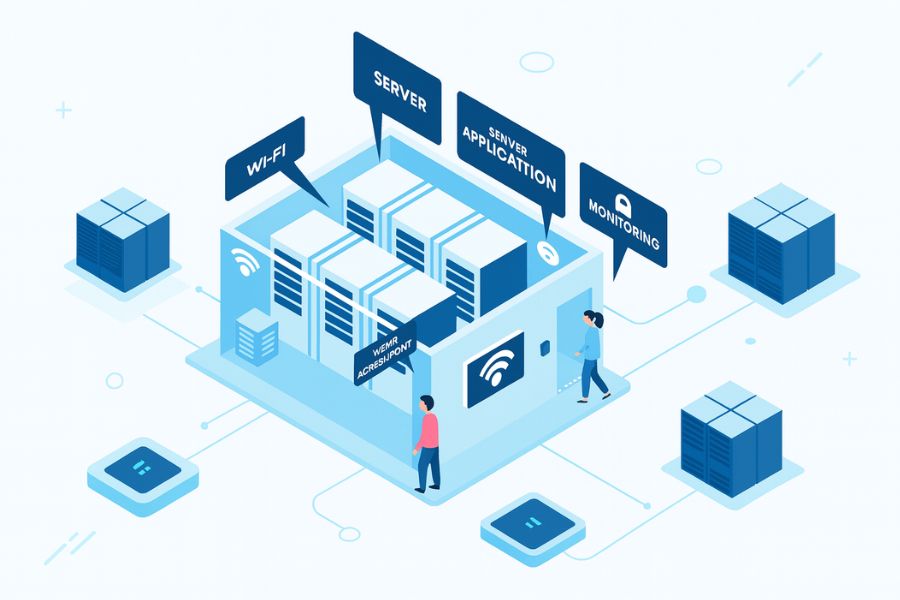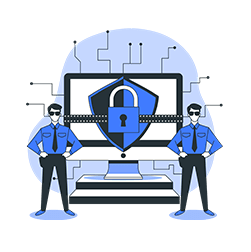
In 2025, hosting reliability in Europe is defined less by raw hardware and more by visibility and control. Enterprises running eCommerce platforms, financial applications, gaming servers, or healthcare systems cannot afford downtime. Every minute offline can cost thousands of euros in lost revenue, damaged reputation, or compliance fines.
This is why IT infrastructure monitoring tools are no longer optional. They form the backbone of data center infrastructure management (DCIM) by providing real-time insights into performance, power, cooling, and network traffic. Proactive monitoring transforms operations from reactive firefighting to predictive resilience.
A frequent query from enterprise clients is: “Which type of server is best?” The answer is clear: a dedicated server housed in a data center that employs robust infrastructure monitoring. Without monitoring, even the most powerful servers risk downtime, inefficiency, and compliance failures.
What Is IT Infrastructure Monitoring?
IT infrastructure monitoring is the continuous observation and management of servers, storage, networking equipment, and applications. It ensures every component of a data center is performing optimally.
Key features include:
- Real-time alerts when thresholds are breached (e.g., CPU usage spikes).
- Trend analysis to forecast future bottlenecks.
- Integration with DCIM for unified visibility across facilities.
Executives often ask: “What is the most reliable server?” The most reliable is a dedicated server colocated in a DCIM-enabled data center where IT infrastructure monitoring tools are actively deployed. This combination ensures both stability and compliance.
Why Monitoring Matters for Uptime and Compliance
Enterprises expect 99.9% or higher uptime SLAs. Without monitoring, these guarantees are impossible to enforce. Monitoring tools matter because they:
- Predict failures before they occur.
- Ensure SLA compliance with automated reporting.
- Support regulations like GDPR, ISO 27001, and NIS2.
- Prevent downtime-related losses, which can reach €5,000–€10,000 per minute for enterprise platforms.
Executives often ask: “How much does a dedicated server cost?” Prices may range from €150–€400 per month, but the real value lies in monitoring and SLA-backed uptime. Without monitoring, the cost of outages quickly surpasses hosting fees.
Key IT Infrastructure Monitoring Tools in 2025
Data centers in 2025 rely on a combination of open-source, commercial, and integrated DCIM tools.
- Nagios & Zabbix: Widely used open-source tools for monitoring servers, networks, and applications.
- SolarWinds & PRTG Network Monitor: Enterprise platforms offering deep visibility across multi-site operations.
- Datadog & Prometheus: Cloud-native tools for real-time analytics and hybrid environments.
- DCIM platforms (Nlyte, Schneider EcoStruxure, Sunbird): Provide end-to-end monitoring for power, cooling, and rack utilization.
A common question is: “Is dedicated server better than VPS?” For long-term performance and compliance, dedicated servers paired with infrastructure managed services and monitoring tools deliver far greater value than unmanaged VPS solutions.
How Monitoring Supports Data Center Infrastructure Management (DCIM)
DCIM systems rely heavily on monitoring to deliver end-to-end visibility and operational efficiency.
- Power monitoring prevents overloads by detecting irregularities in consumption.
- Cooling performance tracks airflow, rack density, and temperature to avoid overheating.
- Asset tracking provides full visibility into hardware usage and lifecycle planning.
- Automated alerts cut downtime by reducing Mean Time to Repair (MTTR).
Executives often ask: “Is dedicated IP faster?” The answer is yes especially when paired with DCIM-managed monitoring, which ensures stable networks and consistent routing performance.
Role of Infrastructure Managed Services
Many enterprises outsource monitoring to infrastructure managed service providers who operate 24/7 Network Operations Centers (NOCs). Benefits include:
- Expert oversight: Continuous monitoring by specialists.
- Predictive analytics: Identifies risks before they escalate.
- Cost reduction: Avoids staffing internal teams for round-the-clock monitoring.
- Compliance assurance: Managed services ensure SLAs are consistently met.
Executives often ask: “Do you need a good GPU to run a dedicated server?” The answer is no. Reliability comes from monitoring, managed services, and redundancy, not GPU horsepower.
Security & Compliance Advantages of Monitoring Tools
IT infrastructure monitoring is not only about performance it is a frontline defense for security and compliance. By integrating monitoring into daily operations, data centers gain both visibility and control over potential risks.
- Detect unauthorized access attempts: Monitoring tools track unusual login activity or privilege escalation, sending instant alerts to security teams. This early detection can stop breaches before they escalate.
- Identify anomalies in traffic: Continuous monitoring highlights irregular traffic spikes, which may indicate a DDoS attack, brute force attempt, or malware infection. Acting fast prevents downtime and data loss.
- Generate audit logs: Regulatory frameworks like GDPR, PCI-DSS, HIPAA, and NIS2 require detailed logs of system activity. Monitoring solutions automatically generate and store these, making compliance reporting seamless.
- Support forensic analysis: When incidents occur, monitoring records help trace the root cause, whether it’s a configuration error, insider misuse, or external cyberattack.
Executives often ask: “How much does Bluehost cost?” Shared hosting might range from €3–€10 per month, but such providers lack enterprise-grade monitoring, compliance reporting, and SLA-backed guarantees. This is why enterprise businesses in Europe choose colocation with integrated monitoring and managed services to stay both secure and compliant.
Scalability and Hybrid Environments
Modern enterprises no longer rely on a single infrastructure model. Instead, they adopt hybrid environments that combine colocation, private cloud, and public cloud resources. This approach provides flexibility, cost control, and resilience but it also increases complexity. That’s where IT infrastructure monitoring tools become indispensable.
- Unified dashboards: Monitoring platforms consolidate performance data from physical servers in colocation facilities and virtual resources in cloud environments. This eliminates silos between IT and facilities teams, enabling real-time visibility.
- Capacity planning: By tracking CPU, RAM, storage, and bandwidth usage across environments, monitoring tools forecast when additional resources are needed. This prevents overprovisioning while ensuring workloads always have enough capacity.
- Performance optimization: Monitoring ensures workloads are balanced properly between on-premises and cloud systems, reducing latency and avoiding bottlenecks.
- Scalability: Enterprises can scale resources seamlessly without disrupting performance, while monitoring ensures growth aligns with SLA and compliance requirements.
Executives often ask: “What is the best dedicated IP provider?” The answer: providers offering RIPE-assigned IPs with integrated monitoring, which guarantee performance, stability, and scalability across hybrid environments.
Industries That Benefit Most from Monitoring Tools
Different industries across Europe depend on IT infrastructure monitoring tools for specific reasons, each tied to uptime, compliance, and user experience.
- Finance & Banking: Real-time monitoring ensures transactions are processed without delay or error. Regulatory compliance (GDPR, PCI-DSS) requires detailed logs, which monitoring tools provide. This minimizes financial risks and protects customer trust.
- Healthcare: Hospitals and clinics depend on patient portals, electronic health records (EHRs), and telemedicine systems. Monitoring guarantees application uptime, data security, and compliance with GDPR and HIPAA standards. Downtime in this sector can directly impact patient care.
- Gaming & Esports: These platforms require ultra-low latency. Monitoring tools track server performance, bandwidth, and application response times to prevent lag spikes and keep competitive gaming environments stable.
- eCommerce: High-traffic events such as holiday sales or flash promotions can overwhelm servers. Monitoring ensures infrastructure scales properly and applications remain online, protecting revenue and customer experience.
- Government & Public Sector: Public services must remain accessible at all times. Monitoring ensures resilience against outages and cyberattacks while protecting sensitive citizen data.
Executives often ask: “Which is the best server in the world?” The answer: an enterprise-grade server colocated in a DCIM-enabled facility, fully monitored by advanced infrastructure tools.
Future of IT Infrastructure Monitoring in Data Centers
The future of IT infrastructure monitoring in Europe will be driven by automation, intelligence, and sustainability. As workloads expand and compliance requirements tighten, data centers must evolve from reactive monitoring to proactive resilience.
- AI & ML integration: Machine learning models will analyze patterns, detect anomalies early, and predict failures before they disrupt services.
- Automated incident response: Instead of waiting for manual fixes, platforms will automatically restart processes, balance workloads, or fine-tune cooling systems.
- Edge monitoring: With 5G and IoT creating thousands of micro data centers, monitoring tools must provide real-time visibility into distributed environments.
- Sustainability metrics: Carbon tracking, power efficiency, and cooling optimization will become standard as ESG goals gain importance.
Executives often ask: “What is the best CPU for a dedicated server?” While AMD EPYC and Intel Xeon lead the market, it’s advanced monitoring that ensures these CPUs consistently perform under heavy demand.
Why Every Data Center Must Prioritize Monitoring Tools
In 2025, IT infrastructure monitoring tools are no longer optional they are mission-critical. Data centers that fail to adopt proper monitoring face higher risks of downtime, SLA violations, and non-compliance with European regulatory frameworks such as GDPR and NIS2. Downtime does not just mean lost productivity; it often results in financial penalties, reputational damage, and customer churn.
Executives often ask: “Does Contabo VPS have GPU?” While some VPS plans do offer GPU capabilities, this highlights a common misconception hardware power alone does not guarantee performance. Without robust monitoring, even the most advanced CPUs or GPUs can underperform due to bottlenecks, misconfigurations, or undetected failures.
For enterprises across Europe, providers like NexonHost offer more than just infrastructure. They deliver a complete ecosystem of DCIM platforms, IT infrastructure management, and real-time monitoring services designed to ensure uptime, security, and cost-efficiency. By combining monitoring with managed services, businesses can proactively resolve issues, optimize resource allocation, and scale with confidence.
The message is clear: data centers that prioritize infrastructure monitoring tools will lead the market in reliability, compliance, and growth, while those that neglect them risk being left behind.


Leave a Reply